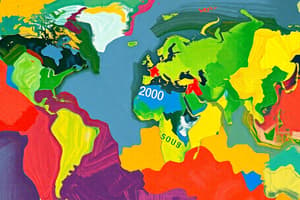Podcast
Questions and Answers
What does the Capital Account in the Balance of Payments primarily record?
What does the Capital Account in the Balance of Payments primarily record?
- Transactions of non-produced, non-financial assets like real estate (correct)
- Transactions involving changes in foreign exchange reserves
- Transactions of goods and services between countries
- Transactions involving international lending and borrowing
Which of the following is NOT typically included in the Current Account of the Balance of Payments?
Which of the following is NOT typically included in the Current Account of the Balance of Payments?
- Investing in foreign assets (correct)
- Transfers like foreign aid
- Receiving payments for services
- Buying or selling goods and services
What primarily influences foreign exchange rates?
What primarily influences foreign exchange rates?
- International lending and borrowing activities
- Interest rates, inflation rates, economic performance, and political stability (correct)
- Changes in foreign exchange reserves
- Transfer of ownership of existing companies
Which statement best describes international transactions?
Which statement best describes international transactions?
In the Balance of Payments, which category covers transactions of foreign direct investments?
In the Balance of Payments, which category covers transactions of foreign direct investments?
What is the purpose of the Balance of Payments in the context of international finance?
What is the purpose of the Balance of Payments in the context of international finance?
What is the primary purpose of the Balance of Payments (BOP)?
What is the primary purpose of the Balance of Payments (BOP)?
Which account in the Balance of Payments includes transactions related to international trade in products?
Which account in the Balance of Payments includes transactions related to international trade in products?
What type of transactions fall under the Capital Account in the Balance of Payments?
What type of transactions fall under the Capital Account in the Balance of Payments?
Which factor plays a key role in determining foreign exchange rates?
Which factor plays a key role in determining foreign exchange rates?
Which term refers to financial transfers that occur without any financial benefit in return?
Which term refers to financial transfers that occur without any financial benefit in return?
In the context of international finance, what do unilateral transfers represent?
In the context of international finance, what do unilateral transfers represent?
Flashcards are hidden until you start studying
Study Notes
Understanding International Finance: Balance of Payments, Current Account, Capital Account, and Exchange Rates
International finance refers to the movement of goods, services, and financial assets across national borders. This intricate web of transactions is tracked through a fundamental tool called the Balance of Payments (BOP). Let's explore the components of the BOP, as well as the current account, capital account, and foreign exchange rate determination, to better understand the global financial landscape.
Balance of Payments
The Balance of Payments (BOP) is an accounting statement that summarizes a country's economic transactions with the rest of the world during a specific time period. It is divided into two main accounts: the Current Account and the Capital Account.
Current Account
The Current Account encompasses transactions of goods, services, and unilateral transfers.
- Goods: The physical exchange of products between countries, conducted through international trade.
- Services: The provision of services, such as tourism, transportation, and engineering, between countries.
- Unilateral Transfers: Financial transfers that occur without any financial benefit in return, including foreign aid, remittances, and interest on debt.
The Current Account's transactions are the most visible and immediate, and they often make headlines when discussing the economy's health and global trade relations.
Capital Account
The Capital Account records transactions that involve the acquisition, disposal, or revaluation of non-produced, non-financial assets, such as real estate, and the transfer of ownership of existing companies. It also includes international lending and borrowing activities, as well as foreign direct and portfolio investments.
International Transactions
International transactions are the exchanges that occur between countries. They include both current transactions and capital transactions, such as:
- Buying or selling goods and services
- Making or receiving payments for services
- Making or receiving transfers like foreign aid
- Investing in foreign assets
- Receiving or sending capital
Foreign Exchange Rate Determination
The foreign exchange rate is the price of one country's currency in terms of another country's currency. It is an essential component of international finance as it influences trade and investment flows between countries. Foreign exchange rates are determined by the interplay of supply and demand and are influenced by various factors, such as interest rates, inflation rates, economic performance, and political stability.
The Role of the BOP in Economy
The Balance of Payments provides a comprehensive picture of a country's economic interactions with the rest of the world. It includes a country's current account and capital account transactions, as well as changes in foreign exchange reserves and the official settlements balance. A country's BOP can provide insights into its economic health, trade policies, and exposure to global forces, which is why it remains an essential tool for economic analysis, policy formulation, and strategic decision-making.
In summary, international finance encompasses transactions that occur between countries, and the balance of payments provides a framework to understand these transactions. The balance of payments is divided into two primary accounts: current account and capital account. The current account covers transactions of goods, services, and transfers, while the capital account includes transactions like foreign direct investments, portfolio investments, and international lending and borrowing. The foreign exchange rate is an essential component of international finance, as it influences trade and investment flows between countries. The balance of payments serves as an essential tool for understanding a country's economic interactions with the rest of the world.
Studying That Suits You
Use AI to generate personalized quizzes and flashcards to suit your learning preferences.




